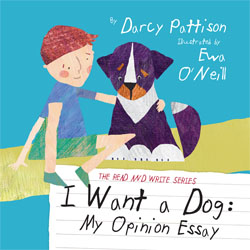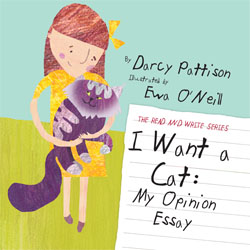new posts in all blogs
Viewing: Blog Posts Tagged with: Novel Revision, Most Recent at Top [Help]
Results 26 - 50 of 257
How to use this Page
You are viewing the most recent posts tagged with the words: Novel Revision in the JacketFlap blog reader. What is a tag? Think of a tag as a keyword or category label. Tags can both help you find posts on JacketFlap.com as well as provide an easy way for you to "remember" and classify posts for later recall. Try adding a tag yourself by clicking "Add a tag" below a post's header. Scroll down through the list of Recent Posts in the left column and click on a post title that sounds interesting. You can view all posts from a specific blog by clicking the Blog name in the right column, or you can click a 'More Posts from this Blog' link in any individual post.
Join Leslie Helakoski and Darcy Pattison in Honesdale PA for a spring workshop, April 23-26, 2015. Full info
here.
COMMENTS FROM THE 2014 WORKSHOP:
- "This conference was great! A perfect mix of learning and practicing our craft."�Peggy Campbell-Rush, 2014 attendee, Washington, NJ
- "Darcy and Leslie were extremely accessible for advice, critique and casual conversation."�Perri Hogan, 2014 attendee, Syracuse,NY
Today, I worked on a difficult scene. It wasn’t a big action-packed scene; those are easy. Instead, it was a transition scene that moved the story along a week and had the potential to lose the reader with it’s lack of tension.
Donald Maass, in his Writing the Breakout Novel Workbook, repeats this signature mantra, “Tension on every page.”
He points out three types of scenes that can be a trap for the lazy writer: Tea time or any time people eat together; transporting characters from one spot to another; and dialogue. Maass recommends that you cut these scenes:
The most controversial part of my Writing the Blockbuster Novel workshop pis this exercise, in which I direct authors to cut scenes set in kitchens or living rooms or cars driving from one place to another, or that involve drinking tea or coffee or taking showers or baths, particularly in a novel’s first fifty pages. Participants look dismayed when they hear this directive, and in writer’s chat rooms on the Web it is debated in tones of alarm. No one wants to cut such material.
Unless you give these scenes careful attention, they can wind up as BORING!
Strategies for Dealing with Low Tension Scenes

In working through my scene, I focused on a couple strategies for approaching such Bore-Traps.
The moment before. What happened right before this scene? Characters don’t go into a scene neutral. Sometimes, just thinking about the moment before will help you get a handle on what tensions or conflicts could be built into the scene. For example, if Jillian and Dad step out of the car at a used-car dealership and talk to a salesman about the 2012 Toyota Camry, it could be boring: How much is it? Do you finance? Want to take a test drive?
If, however, you take a moment to explore the moment before, you might find some interesting points of tension:
Our salesman, William, has just learned that his brother was in a motorcycle wreck and while he lived, William is now obsessing about car safety. Jillian has been trying to convince her Dad to get her a new car and is angry that he’s stopping at the used car shop, while Dad is worried because Mom just told him she’s filing for divorce and Dad doesn’t know how he can afford to buy Jillian any kind of car, what with the upcoming lawyer bills. Try writing that scene again, after all of THAT!
Character’s attitudes going into a scene. Similar, but slightly different is an emphasis on character attitudes going into a discussion. For William, we could choose from several attitudes: obsessing over safety, anxious to get done and get to the hospital so he speeds through everything, angry with brother because William just convince his wife to get a motorcycle and his blockhead brother just messed up that deal. Jillian could be pleading, sarcastic, grateful, or even indifferent. Dad could be generous, angry, stingy, resentful and more. Decide on the character’s attitudes, making sure that they are coming into the discussion at tangents.
Small moments of tension. This may seem obvious, but what I mean by this is to look for things or situations within the scene that could go wrong. For example, in my current story, the kids are in a cafeteria, and when the boy opens his coke, the carbonation explodes all over. It’s a small thing, a common thing. But it’s conflict. What is present in your situation/scene that could spill over with some small conflict?
Foreshadow something that is coming – look forward. Another reason the coke explosion worked for me is that the story involves volcanoes! It’s a minor foreshadowing of what’s coming. Look ahead in your story to see if you can provide even a minor foreshadowing.
Refer back to something – look backward. Don’t just look forward. Also look back to previous chapters and try to echo something. Can you echo it with some kind of progression? Make it faster, higher, bigger, etc? And plan another time to use that element and make it the fastest, biggest, highest, etc.?
My scene, which started as a bore, is much tighter and has more tension. It’s a collection of small moments of tension that adds up to an important transition scene that keeps the reader turning the pages.

Join Leslie Helakoski and Darcy Pattison in Honesdale PA for a spring workshop, April 23-26, 2015. Full info
here.
COMMENTS FROM THE 2014 WORKSHOP:
- "This conference was great! A perfect mix of learning and practicing our craft."�Peggy Campbell-Rush, 2014 attendee, Washington, NJ
- "Darcy and Leslie were extremely accessible for advice, critique and casual conversation."�Perri Hogan, 2014 attendee, Syracuse,NY
Tension on every page is the mantra for fiction writers. But what if your tension is spread unevenly throughout the story? That may be fine, because stories need a natural rhythm, an ebb and flow of action, thoughts, dialogue and reflection (inner dialogue). Some scenes may be crammed with small actions, while others pace steadily through the setting. Sometimes, though, I find that I’ve packed a scene with too many MAJOR revelations or actions, creating a top-heavy scene; that scene is usually matched by another scene that lacks enough tension.
My current WIP was in that position this week. One scene had two major confrontations. So, I decided to see if I could lift one Major Complication and put it elsewhere. The actual text, a revelation that someone was searching for the main character, took about 20 lines of text. Not so bad to move elsewhere, I thought.
But every part of a story is intertwined with every other part.
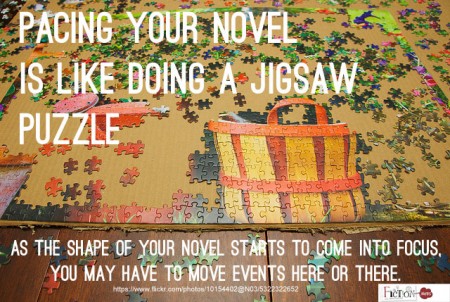
Timeline. First, there’s timeline issues. EventA happens before EventB. The RevelationEvent was originally the EventA, but I moved it to an EventC position, which meant that I had to go back and clean up the time line. There could be no mention of the RevelationEvent before Event B, of course. This is tedious work. You have to reread chapters thinking about what a reader should know at this point in the story, and make sure there’s no hint of the RevelationEvent that will spoil the surprise. Of course, I can hint at it; that’s called foreshadowing. Foreshadowing’s role, though, is to make the reader slap his/her forehead and say, “Duh! That’s exactly what should happen. Why didn’t I see it coming?” The reader should still be surprised, but the surprise is believable. Cleaning up the timeline is hard work, and if you slip up with even one half-sentence, you’ll be nailed on it by some alert reader.
Fitting it in. Unfortunately, you can’t just pick up the 20 lines and insert them where Event C occurs. Much of it may be salvaged verbatim, but much of it needs to be worded differently at the new place of the story. Keep the core of it, the meaning, but be willing to rewrite to make it seamless. The goal is to make it seem that the story was originally written this way.
As a revision exercise, I required my freshman composition students to write eight different openings for their essay. Often, the third or fifth or eighth opening was dynamite, and the writer chose to start his/her essay with it. Too often, though, it was stuck on the front and had no relationship to the rest of the story. I modified the assignment: students still wrote the eight openings. But then, in class to make sure they did it, they had to start writing the essay again from that starting point and keep writing for a timed period. I made sure the writing time was long enough to carry them into the body of the essay. That resulted in strong openings that were integrated into the whole essay. That’s what you want here, too.
One caution: keep a copy of the original version, because you may not like moving the event to a new place. In Scrivener, take a snapshot. In word processors, make a backup copy or a versioned copy; or use track changes to make the preliminary changes and then decide if you want to make them permanent.
The strategy of moving events is easy on the imagination. I don’t have to think up new events or complications; instead, I just need to use what I’ve already written in a stronger way.

Join Leslie Helakoski and Darcy Pattison in Honesdale PA for a spring workshop, April 23-26, 2015. Full info
here.
COMMENTS FROM THE 2014 WORKSHOP:
- "This conference was great! A perfect mix of learning and practicing our craft."�Peggy Campbell-Rush, 2014 attendee, Washington, NJ
- "Darcy and Leslie were extremely accessible for advice, critique and casual conversation."�Perri Hogan, 2014 attendee, Syracuse,NY
Today launches two new books for me.
How the Stories Started. For years, I’ve taught writing. I teach everything from kindergarteners to advanced novelist, gifted-and-talented kids to reluctant writers. I’ve developed techniques for helping people write stronger and they usually involve either revising or prewriting. In schools, it’s hard to get kids to revise; they see it as torture to copy out a perfectly good essay again. Too often, it’s an exercise in handwriting instead of real revision. So, I started flipping the process and putting more emphasis on prewriting. A rich prewriting environment gives a student a better chance at a good first draft (which is often the only draft). A single prewriting activity isn’t enough; instead, you want a rich environment with multiple ways of thinking, discussing and drafting about a topic.
Everything I’ve learned about teaching writing an opinion essay to kids is instilled in these two books in just 500 words (Dog) and 750 words (Cat). Cousins discuss the type of dog/cat they want for their family. They use about ten criteria (and another 5-6 criteria are suggested in the back matter) to decide what breed of dog/cat is best. Then, they write an opinion essay. And because all writing should have a real world effect and be successful, they get the dog/cat of their dreams.
Characters. I knew that I wanted to write something helpful to teachers about writing essay; however, first and foremost (as always) I wanted to write a fun STORY. The relationship between cousins Dennis and Mellie was important to develop. Each has a different family life, so their priorities on a pet differed drastically. Creating interesting characters helped ground the information in a story.
Research. Do you research topics for a fictional story? It was crucial for these two stories that I had the facts right about the dogs and cats. The American Kennel Club (AKC) regularly publishes information on the most popular breeds of dogs for a particular year. I used the latest data from 2013 and decided to feature the top 20 breeds of dogs: in order of popularity – Labrador Retrievers, German Shepherd Dogs, Golden Retrievers, Beagles, Bulldogs, Yorkshire Terriers, Boxers, Poodles, Rottweilers, Dachshunds, French Bulldogs, Doberman Pinschers, German Shorthaired Pointers, Siberian Huskies, Shih Tzu, Great Danes, Miniature Schnauzers, Cavalier King Charles Spaniels, Pomeranians, Australian Shepherds.
Then, it was a juggling act to slot each breed into a criteria for deciding for/against a breed. I used the Animal Planet’s Dog Breed Selector Tool as a beginning point, and filled in with research on each breed. Many dogs are friendly; some dogs are better at being a guard dog than others. Each criteria needed a matched pair, one dog included by the criteria and one breed excluded by the criteria. It was impossible to satisfy every breed enthusiast, but the AKC went through the manuscript and approved the way the breeds were described.
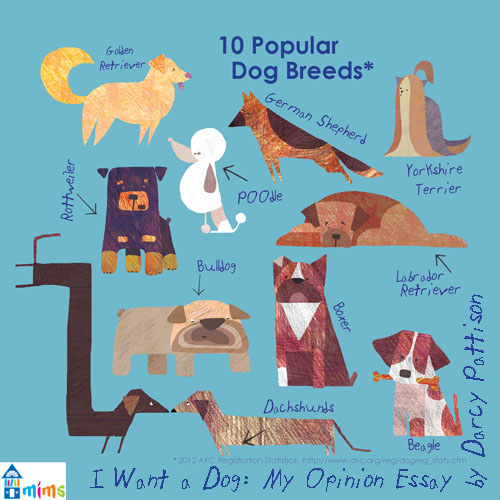
For the Cat Lovers. I was pleased with the story and sent it around to a couple editors. One was very interested, but eventually rejected the story, saying, “A dog story just isn’t for me. I’m just a cat lover.” That weekend, I wrote the companion book, I WANT A CAT: My Opinion Essay. It went through a similar process using the Animal Planet Cat Breed Selector Tool, and generous input from Joan Miller, Chair of the Cat Fancier’s Association Outreach & Education efforts.
The CFA statistics say these are the top 20 cat breeds, in order of popularity: Persian, Exotic, Maine Coon Cat. Ragdoll, British Shorthair, Abyssinian, American Shorthair, Sphynx, Siamese, Devon Rex, Norwegian Forest Cat, Oriental, Scottish Fold, Cornish Rex, Birman, Burmese, Tonkinese, Siberian, Russian Blue, Egyptian Mau
I was unfamiliar with some of the breeds, so Miller’s input was invaluable–thanks, Joan!
Illustrator: Ewa O’Neill
These are debut picture books by European illustrator, Ewa O’Neill. She’s got an eye for color and design! A dog-lover, she studied the twenty dog breeds and twenty cat breeds to create active, interesting collection of pets.
Free on Kindle for 5 Days
Amazon allows certain promotional events and I’m happy to say that I WANT A DOG: My Opinion Essay will be a free Kindle book from February 8-12. Get it during these five days and spread the word to your friends.
Free on KOBO and Apple: I WANT A DOG and I WANT A CAT will be free for your iPad or Kobo reader on February 13-17. Check the iBookstore and KoboStore then. Sorry, a Nook version is not available. You can also find ebook copies at MimsHouse.com – Dog and MimsHouse.com – Cat.
Both books are available in paperback and hardcover.
Coming Fall, 2015: My Crazy Dog: My Narrative Essay

Join Leslie Helakoski and Darcy Pattison in Honesdale PA for a spring workshop, April 23-26, 2015. Full info
here.
COMMENTS FROM THE 2014 WORKSHOP:
- "This conference was great! A perfect mix of learning and practicing our craft."�Peggy Campbell-Rush, 2014 attendee, Washington, NJ
- "Darcy and Leslie were extremely accessible for advice, critique and casual conversation."�Perri Hogan, 2014 attendee, Syracuse,NY
Last year, I did a simple survey on the list and asked writers, “What is your biggest challenge for 2015?”
The answer blew me away. You want to know, “Is my picture book/novel/short story/piece of writing any good?”
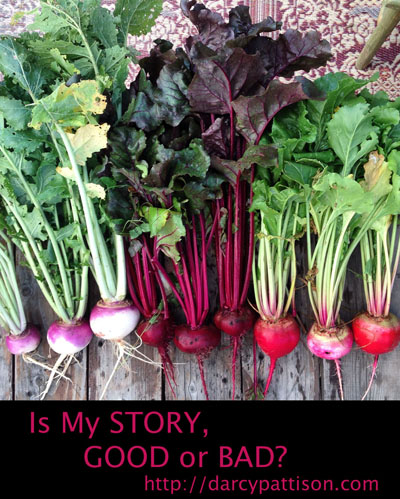
This was expressed in many different ways, of course, but at the core, you want to know what makes one piece of writing good and one piece of writing bad. Is it just a matter of opinion?
When I taught freshman composition, this was a constant problem, as well. An essay turned into one teacher might receive an A, while the second teacher gave it a C; giving grades is one way to answer the good/bad question. Research showed that the solution was simple: teachers needed to meet and discuss criteria for grading. Once they’d gone through a couple essays together, they were more likely to grade consistently.
Why the problems? What does make good writing? The answer isn’t about grammar, and only incidentally about the content of the piece. Instead, you must look at the fuzzy concerns of audience, purpose, genre conventions,
AUDIENCE
Who are you writing for? Do you take the time to search images till you find a person who is your ideal audience? Writing for a middle grade student is very different than writing for a middle-aged history professor.
Again, let me demonstrate this with an example I gave to my freshman comp students. Let’s say that an 18-year-old boy has a car wreck. Now, he must tell three people about that wreck: the policeman, his mom, and his best friend. You can easily imagine each conversation. The tone—apologetic to bravado—changes with the audience. Details creep into some accounts (To Best Friend: Mary was tickling me) and are deleted from others (To Mom and Cop: I was under control of the vehicle at all times).
Which account of the car wreck would be considered “good” and which is “bad”? Is one more truthful than the other; i.e. can you apply the criteria of truthfulness to determine good/bad? You’ll agree that tone, voice, content, style and more depend on the audience.
PURPOSE
When you write a novel, do you want your reader to weep or to guffaw? The purpose of any piece of writing should—in a sane world—determine its effectiveness. Did it accomplish what you set out to accomplish?
In other words, can we use effectiveness of communication as one measure of good/bad?
GENRE CONVENTIONS
Think with me of what you expect from a mystery novel. There’s a murderer, a detective and a dead body (victim). Beyond that, though, one common convention in a mystery is to TELL the answer to the mystery. The detective arranges for all the suspects to be present at the same time, and then explains how s/he cleverly solved the problem. When confronted, the murderer tries to run away. That sort of scene would rarely happen in other genres.
Each genre has its own conventions of characters, events, plot points, settings, and so on. If you break or bend those conventions, you risk angering your readers, who will exclaim loudly, “This is a horrible mystery.”
Is it good writing or bad writing? Wrong question.
Is it a good mystery (according to the genre conventions of today)?
Is My Picture Book Manuscript Any Good?
Do you need to know if your picture book manuscript fits genre conventions? Darcy Pattison and Leslie Helakoski will be teaching PB&J: Picture Books and All that Jazz, April 23-26, 2015 at the Highlight’s Foundation, Honesdale, PA. Learn more about the workshop.
If you can’t see this video, click here.
DOES THE STORY PLEASE YOU?
Aside from issues of audience, purpose, and genre, there’s one that looms large in my mind. Does the story please you, the author? Are you happy with what you’ve done? It’s very hard to step back from your work and evaluate it. Your worries about what others think consumes you, and you can’t separate THEIR opinion from YOUR opinion.
I recently re-read my latest novel, LONGING FOR NORMAL, and at a certain point, it made me cry. A friend read it recently, too, and I asked her, “Did you cry at XXX scene?” No, she didn’t. But when I re-read that scene, I always cry. Is it a good scene? It touches me emotionally in a deep way; but it doesn’t affect my friend the same way. Is it good? Or bad?
Do you start to see that the question is the wrong one? Or that there are really two questions here:
1. Did I write the story I wanted to write?
2. How will others respond to that story?
And the terminology that you use should NOT be good/bad.
Instead, try these criteria: useful, effective, matches genre expectations, pleases me.
Then, you need to ask a final question: Do I want this to be published?
If so, you forget the good/bad question and find a publisher whose purposes, audiences and genre fits what you’ve written. And send it in. Period.
Stop those pestering questions about good/bad. Send it in. You’ll soon find out if it will fly in the marketplace you’ve chosen. If it doesn’t, go back and ask the right questions again: useful, effective, matches genre expectations, pleases me? If you’re sure you’re on target, send it out again. And again and again. Repeat until you find the right market for your work!

Join Leslie Helakoski and Darcy Pattison in Honesdale PA for a spring workshop, April 23-26, 2015. Full info
here.
COMMENTS FROM THE 2014 WORKSHOP:
- "This conference was great! A perfect mix of learning and practicing our craft."�Peggy Campbell-Rush, 2014 attendee, Washington, NJ
- "Darcy and Leslie were extremely accessible for advice, critique and casual conversation."�Perri Hogan, 2014 attendee, Syracuse,NY
As 2014 events unfolded in Ferguson, Missouri and in New York City over race relations, I watched with a storyteller’s eye. That’s not to make light of the events–which have sparked massive debates and outrage. Rather, I put on my writer’s glasses and tried to evaluate the news reports AS A WRITER.
Conflict on Every Page: What Kind of Conflict?
Many writing teachers drum it into their students heads: conflict on every page.
What they mean is that something has to happen on every page that makes the situation worse for the characters. Storytelling is about the problems of life, not the happy moments. Happiness is only possible when thrown into relief by contrast with the bad stuff.
This can easily go wrong: after a writing class where conflict was encouraged, one writer added “conflict” by having a wild creature attack a main character; but in the next scene, the character easily escapes and nothing was different. That’s adding in conflict just for the sake of conflict and that’s off-target. Instead, conflict should be integral to the story and make the characters’ lives different in some way.
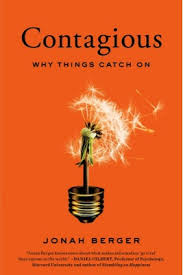 Recently, I found insight into this from a surprising source. In his book, Contagious: Why Things Catch On, Jonah Berger says that things go viral easier when people are met with moments of high arousal. That sounded suspiciously like “conflict on every page.” Berger backs up his claims with various psychological studies (you should read his book for details). The high arousal moments included positive emotions: excitement, awe, inspirations, humor. But they also included negative emotions: anger, disgust, anxiety, and especially outrage.
Recently, I found insight into this from a surprising source. In his book, Contagious: Why Things Catch On, Jonah Berger says that things go viral easier when people are met with moments of high arousal. That sounded suspiciously like “conflict on every page.” Berger backs up his claims with various psychological studies (you should read his book for details). The high arousal moments included positive emotions: excitement, awe, inspirations, humor. But they also included negative emotions: anger, disgust, anxiety, and especially outrage.
In his book, Berger gives examples of Outrage, including one about mothers who carry babies in a special sling. In 2008, the practice was celebrated with the inaugural International Babywearing Week. McNeil Consumer Healthcare, the company who makes Motrin pain medication wanted to support the event. According to Berger, they figured that carrying babies in a sling was great for the mother-child relationship; however, they also thought that it would cause strain on mother’s backs and they would need pain-relief. The advertisement they created, however, caused outrage!
The advertisement implied that mothers wore babies as “a fashion statement,” and it implied that babywearing looked “crazy.”
Outrage swept through the mommy-bloggers. And of course, OUTRAGE brings us back to Ferguson and the problems of racial relations in the U.S. Outrage–as a storytelling element–has been evident in almost every report I saw on the incident.
It’s not redundant to say this: the events in Ferguson were outrageous; the outrage at the events made the news stories successful. So successful that I later heard a radio interview with protestors in Hong Kong who were asked about relations with the police there in Hong Kong. The protestor answered that the relations were just as strained as those between police and citizens in Ferguson. In other words, the outrage–the negative emotional response to events–has been so strong that it has been reported worldwide and has become a symbol of difficult police reactions. That’s the power of outrage in storytelling.
In your story, can you find a place to add outrage? If you can, your story will be stronger.

Join Leslie Helakoski and Darcy Pattison in Honesdale PA for a spring workshop, April 23-26, 2015. Full info
here.
COMMENTS FROM THE 2014 WORKSHOP:
- "This conference was great! A perfect mix of learning and practicing our craft."�Peggy Campbell-Rush, 2014 attendee, Washington, NJ
- "Darcy and Leslie were extremely accessible for advice, critique and casual conversation."�Perri Hogan, 2014 attendee, Syracuse,NY
Openings are incredibly important. This was brought back to me recently as I was judging a contest. Those manuscripts that kept my interest for three pages were rare. Usually, they lost me by the middle of page two!
Am I harsh? I don’t think so.
Grab the Reader with Your Opening Lines
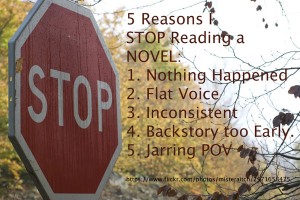
Noah Lukeman has it right in his book, The First Five Pages: A Writer’s Guide to Staying Out of the Rejection Pile. This is a book I ask those attending my Novel Revision retreats to read before they attend. Lukeman’s premise is that an editor will decide if they want your book or not based on the first five pages of your manuscript. After judging this contest, I agree. Sometimes, you can even make a judgment based on the first paragraph.
That first paragraph? You want to grab the reader by the throat and never let go!
Here are five things that made me stop reading
- Nothing happened. The whole first chapter could be cut, because no major action occurred. Ask yourself: what happened in this chapter? Is there any conflict here?
-
The voice was flat. Monotone and uninteresting. Read it aloud: Does the text demand that you use an interesting variation of pitches, tones, stops, starts, etc?
- Inconsistencies. If I found myself thinking, “No, that couldn’t happen. Not that way,” then the story was in trouble. Consider: does the story logic work?
- Backstory. Please don’t put backstory in the first chapter. Give us an active scene with the character in motion and wanting something. It doesn’t have to be the major goal of the book, but the character needs to want something and it should be something that leads into the main conflict. Ask yourself: Do I really need to explain the backstory here, or can I wait until page 100? Yes! Page 100! Move that stuff out of the first act entirely!
- The point-of-view jumps out at me. Too many of the mss had first-person point-of-views that just jumped out at me and made me cringe. In other words, the voice wasn’t distinctive enough for first person. This is a personal opinion–FWIW–but I think too many people are trying to write a first-person narrative. The default should be third-person unless there is a compelling reason for first. It’s not just a bias against first-person, but rather, that the story would be better served from third in many cases.
There were some first-person stories where I didn’t even realize it because the story caught me. When it works, it work well. When it fails, the story might could be salvaged by a switch to third. Consider: Is there a compelling reason for the first-person point-of-view? Could this ONLY be told from first? Try–OK, just try–writing the first chapter from third and give it to an independent, unbiased reader (like you can find that!) and ask which version they like better (don’t tell them what the difference is). I bet that third will win in the majority of cases.



MERRY CHRISTMAS!
Join Leslie Helakoski and Darcy Pattison in Honesdale PA for a spring workshop, April 23-26, 2015. It's a great Christmas present to yourself or a writer friend! Full info
here.
COMMENTS FROM THE 2014 WORKSHOP:
- "This conference was great! A perfect mix of learning and practicing our craft."�Peggy Campbell-Rush, 2014 attendee, Washington, NJ
- "Darcy and Leslie were extremely accessible for advice, critique and casual conversation."�Perri Hogan, 2014 attendee, Syracuse,NY
Thank you!
Your support for the last year has meant so much. And because of your nominations, Fiction Notes has been named one of the Top 10 Blogs for Writers 2015!
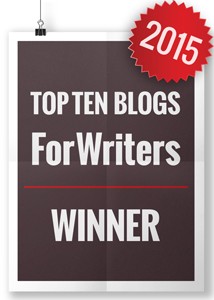
WritetoDone.com has named the 2015 Top 10 Blogs for Writers.
The other blogs named to this honor are amazing! Click on the image to check out the full list.
This blog succeeds only because of readers like you! If you’d like to see a special topic covered this year, please leave a comment and we’ll try to research answers and write a post for you.

MERRY CHRISTMAS!
Join Leslie Helakoski and Darcy Pattison in Honesdale PA for a spring workshop, April 23-26, 2015. It's a great Christmas present to yourself or a writer friend! Full info
here.
COMMENTS FROM THE 2014 WORKSHOP:
- "This conference was great! A perfect mix of learning and practicing our craft."�Peggy Campbell-Rush, 2014 attendee, Washington, NJ
- "Darcy and Leslie were extremely accessible for advice, critique and casual conversation."�Perri Hogan, 2014 attendee, Syracuse,NY
Opening a novel in an interesting way is crucial. I often see stories-in-progress with weak openings. This week, I happened to pick up a copy of the classic Jurassic Park, and I was stopped on the first page with the economy of language. In two brief paragraphs, Crichton sets a scene, introduces a character, puts us into the character’s life, and places us in a Costa Rica fishing village. He accomplishes so much in a brief passage. Let’s look at it to see if it gives us tips on starting our own stories.
Opening of Jurassic Park
The tropical rain fell in drenching sheets, hammering the corrugated roof of the clinic building, roaring down the metal gutters, splashing on the ground in a torrent. Roberta Carter sighed, and stared out the window. From the clinic, she could hardly see the beach or the ocean beyond, cloaked in low fog. This wasn’t what she had expected when she had come to the fishing village of Bahia Anasco, on the west side of Costa Rica, to spend two months as a visiting physician. Bobbie Carter had expected sun and relaxation, after two grueling years of residency in emergency medicine at Micheal Reese in Chicago.
She had been at Bahia Anasco for three weeks. And it had rained every day.
(First two paragraphs of Jurassic Park, Prologue, by Michael Crichton.)
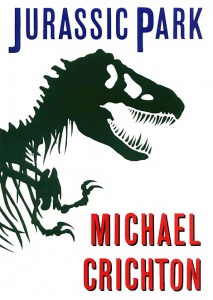
Weak openings leave me confused, wondering where I am and what is going on. Crichton starts with a specific setting. The second word is “tropical,” which narrows down the location on the globe, while also explaining the type of rain. A “corrugated” roof probably indicates a lower income area where cheaper materials are used for construction.
Notice the great verbs which animate that first sentence: fell, hammering, roaring, splashing. And it ends with a strong descriptive word: torrent. This is masterful selection of language. After one sentence, I know approximately where I am and what is happening.
Next, Crichton focuses on the point-of-view character for this section. Because it’s a prologue, this character won’t be important in the story proper, but he takes the time to give us some of her background, which implies much about her state-of-mind.
She is an ER doctor, just finishing her residency in Chicago, and she thought this trip to Costa Rica would be a vacation. Notice that she’s an ER doc. The old sayings is that you should never put a gun in Chapter 1, if you don’t intend for it to go off sometime. Crichton put an ER doctor in the first paragraph because someone soon would require emergency medical attention. We know Roberta/Bobbie (Notice how he named her fully, then gave us a more casual nickname) is skilled in medicine, but she’s also tired and disappointed with this location.
As far as setting a mood, the torrential storm sets up the possibility of something happening. We’d expect that a “torrent” would bring other problems with it.
Finally, Crichton actually names the locale: Bahia Anasco on the western coast of Coast Rica.
Setting, mood, characterization, anticipation–Crichton sets up so much in just two short paragraphs!
Applying Crichton’s Lessons to Your Story
Setting. Readers need to be oriented immediately to the location of your story. While you describe the setting, use language to create a distinctive mood and set up anticipation. Don’t be afraid to name a location directly.
Mood. Choose language that sets up a distinctive mood. The torrential rain is described with evocative verbs and language. Strong, forceful, a force of nature–you expect something to happen, and soon.
Characterization. It’s important to know something about the character. Crichton gives us a name, place of origin (Chicago hospital), and something of her inner life. Bobbie is a strong-willed woman or she wouldn’t be an ER doctor; but she’s tired because of the “grueling” residency. Bone-weary, maybe. The impending emergency that will require her skills will challenge her, not because she’s not capable, but because she’s so tired. That’s great characterization for one paragraph!
Anticipation. How can you not turn the page? Crichton has set up an interesting enough scenario, and populated it with an interesting character that I’m hooked. I would read on! Wouldn’t you?
Avoid weak openings! Study Jurassic Park for hints on how to take your story’s opening to a new level.

MERRY CHRISTMAS!
Join Leslie Helakoski and Darcy Pattison in Honesdale PA for a spring workshop, April 23-26, 2015. It's a great Christmas present to yourself or a writer friend! Full info
here.
COMMENTS FROM THE 2014 WORKSHOP:
- "This conference was great! A perfect mix of learning and practicing our craft."�Peggy Campbell-Rush, 2014 attendee, Washington, NJ
- "Darcy and Leslie were extremely accessible for advice, critique and casual conversation."�Perri Hogan, 2014 attendee, Syracuse,NY
Notes from the Field
During the holidays, it’s hard to concentrate on a story. But it’s not hard to BE a writer. As you go to gatherings of friends and families, one thing you can do is EAVESDROP!
In your story, you want dialogue to sound natural. One way to study dialogue is to just listen and record. At holiday gatherings, you may hear undercurrents of sibling rivalry, jealousy, reconciliation, or love. Usually, these things aren’t said on the surface, so much as in the subtext, or what is understood beneath the surface.
Try this: Take a pad of paper and a pencil/pen with you. Sit off to a side or in a corner, and furiously write everything you hear said in a specific conversation for ten minutes. Later when there’s time, look it over and see what you’ve learned about dialogue. OR, if your family is generous and agrees, find an app to record an hour of conversation! Thanks, fam!
So, here are my notes from the field for a couple hours, recording exactly what I said–just my side of a conversation. Notice how MUCH you can tell about the events and what others are saying just by the snippets of dialogue. (Names and phone numbers XXX-out to protect the innocent.)
Getting daughter out of bed

Photo credit: https://www.flickr.com/photos/dani_vazquez/10479425133
I don’t have time to be gentle.
That helps.
No, you can’t consistently count on it. It’s not your car.
Before and During Breakfast
He’s not up yet.
I’ve been in there once or twice.
I need to eat.
I’ve messed around too long.
Could you clean up the kitchen, do the things you haven/t done in two days.
Where? What?
It would be easier with a comb.
Too late now.
We gotta remember to take the trash out.
Nothing.
Oh, man!
Mine.
Both of you stop.
It’s not just her. It’s you, too.
Stop! XXX, don’t take that in your room, please!
Ok.
No. No. It’s a mess.
Whose spoon is this?
Just ‘sec.
Tell MMM she has e-mail.
Five?
What is it, oh, a Pokemon?
ZZZ, work on that kitchen now.
It used to be a road.
What?
Wow. How much?
$15 isn?t bad at all. Who’s sponsoring it?
Cool. It’s not bad.
I’m gonna shower.
I’m gonna shower.
Fix–transmission?
Huh? I’m totally lost.
Oh, OK.
OH, well.
Gimme kiss.
Yes. To school?
No. Gimme kiss.
Lots more than that. I’ll be in the library today. At noon. XXX has to stay ?’til 4. So we?ll just stay.
You might as well read.
Good.
Yep.
Have a good day.
Taking truck to shop
Last night, we lost 3rd and 4th gears. You can put it in gear but you have to hold the stick. 1st, 2nd & 5th are OK.
OK.
Oh, and he said to change the oil and a nut on the valve cover is missing.
Pattison. I-s-o-n. Not e-r.
We also have a Sienna van so we should be in the computer.
Let me give you his number. XXX-XXXX.
OK.
A second number XXX-XXXX. But I’ll be gone a lot, so try him first.
And give us an estimate. Just give us an idea of how long would help.
He’s coming to get me, so I?ll just go in the waiting room.
Don’t change the oil first. Let us know how much on the transmission first.
Is that all you need?
Driving to work with DH
She said she’d call you with an estimate. It’ll probably take over night.
Where’s my glasses?
My headache is coming back.
No, on the other side.
Yep.
Yeah.
Uh huh.
Uh huh.
So, which do you like?
What is all that?
Huh?
Yep. That’s the one you said I could have? I could put it on my business cards?
That’s weird.
Strange. I gotta call XXXXXX. About YYY.
Where’s the check book? I need one for this doctor’s visit.
Bad time for a vacation with all the other guys messed up.
Wow. Must be nice.
Yeah. He’s the best marketer.
Which one?
That’s good.
By who?
I should be able to make it to the doctor by nine. I was hoping I could go be the house and eat, though. I need to go by and see XXX and then–I need to buy crickets. (Note: to feed the lizards.) And I?ll bring you the car just before 12.
Okay. I know.
Helicopter.
Where?
Yeah.
Kinda misty on the river today.
Yeah, I know.
It was weird yesterday.
Yeah. Like what?
I haven’t heard of him.
What are they building over there?
Boy, that looks terrible. It’s big. Well–it’s just big. Wow. That’s amazing.
I have my keys. I need a check.
Was it on the table?
That’s right. Love you.
Saying Hi to Neighbor
Good morning.
Pretty good.
Already in a rush.

MERRY CHRISTMAS!
Join Leslie Helakoski and Darcy Pattison in Honesdale PA for a spring workshop, April 23-26, 2015. It's a great Christmas present to yourself or a writer friend! Full info
here.
COMMENTS FROM THE 2014 WORKSHOP:
- "This conference was great! A perfect mix of learning and practicing our craft."�Peggy Campbell-Rush, 2014 attendee, Washington, NJ
- "Darcy and Leslie were extremely accessible for advice, critique and casual conversation."�Perri Hogan, 2014 attendee, Syracuse,NY
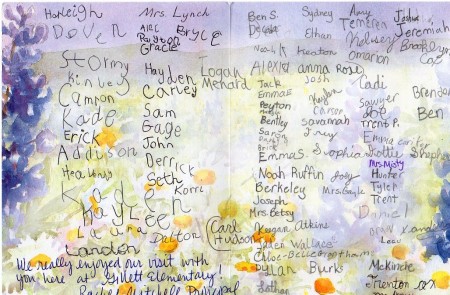
I visited Gilett Elementary School last month and look at the great Christmas card the kids just sent me! What a thrill to get a card like this! Merry Christmas!

MERRY CHRISTMAS!
Join Leslie Helakoski and Darcy Pattison in Honesdale PA for a spring workshop, April 23-26, 2015. It's a great Christmas present to yourself or a writer friend! Full info
here.
COMMENTS FROM THE 2014 WORKSHOP:
- "This conference was great! A perfect mix of learning and practicing our craft."�Peggy Campbell-Rush, 2014 attendee, Washington, NJ
- "Darcy and Leslie were extremely accessible for advice, critique and casual conversation."�Perri Hogan, 2014 attendee, Syracuse,NY
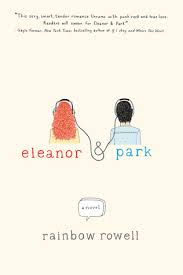 I am currently reading Eleanor and Park, a YA romance; one of the interesting things about this story is the author’s choice to create a sensual tone. It’s not sexy or intellectual. The choice of tone is interesting because often a romance can devolve into physical stuff of sex.
I am currently reading Eleanor and Park, a YA romance; one of the interesting things about this story is the author’s choice to create a sensual tone. It’s not sexy or intellectual. The choice of tone is interesting because often a romance can devolve into physical stuff of sex.
Instead, Rowell walks a fine line between the two extremes. It’s sensual because there are physical details. For example, Eleanor notices Park’s hands:
Park’s hands were perfectly still in his lap. And perfectly perfect. Honey colored with clean, pink fingernails. Everything about him was strong and slender. Every time he moved, he had a reason.
Or Park, describing holding Eleanor’s hand:
Holding Eleanor’s hand was like holding a butterfly. Or a heartbeat. Like holding something complete, and completely alive.
Creating the Right Tone
The question is, of course, what tone do I want for my story?
That’s what a writer does as they read great stories from other writers: you think about what they are doing that is working so well, and how to translate that into your own stories.
Do I want a romance that is intellectual, sensual, sexy, titillating, mysterious, or something else? How do I achieve that?
First, I pay attention to the tone of my drafts. While I’m writing, I work hard to characterize, to plot, to evoke a setting. But I’m also paying attention to the word selection and how that affects tone. Sentence structure can affect tone, as can the rhythm patterns created by a combination of words and sentences.
First drafts are about approximating: you want to get close to the target of a great story. As I revise, I am refining so many things, but one of those is the right tone.
It may also mean that I do a couple trial drafts. How does a sexy tone fit with the rest of the story? How does an intellectual romance mesh with the action plot? Experimenting with different tones is sometimes essential. I know that my story should have a lot of action, and I’m comfortable with the tone I’ve created for that part of the story. But integrating that with the romance subplot is trickier this time. The goal is an integrated story, a whole story.
Tools to Create Tone
Writers have only a few tools: words, sentences, paragraphs. That’s it.
Words. Think about the connotations of each word/phrase you choose.
Sentences. While short sentences can speed up an action, long sentences can languish and slow down a story.
Paragraphs. And overarching is how the words, sentences, meaning, and connotations blend to create the right rhythms.
Most of all, don’t leave tone to chance. Decide what tone works for your story, and then work to make it happen.

NOW AVAILABLE! 30 Days to a Stronger Novel Online Video Course
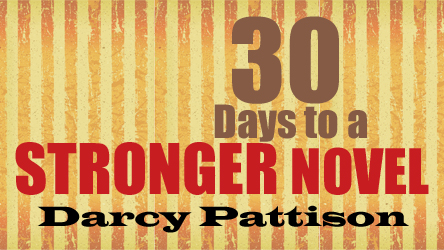
I recently found a gem of a writing book. For my NaNoWriMo challenge, my current love/hate WIP, I decided I wanted to include more action scenes, pushing it more toward YA and more toward a true action book. OK. Action. That should be easy. Um. No.
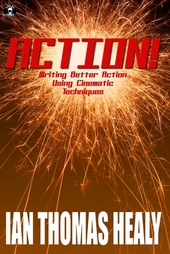 Until I read this book. Ian Thomas Healy breaks down action into manageable chunks in his book, Action! Writing Better Action Using Cinematic Techniques.
Until I read this book. Ian Thomas Healy breaks down action into manageable chunks in his book, Action! Writing Better Action Using Cinematic Techniques.
The title appealed to me right away because I do like action/thriller movies, and I recognize that writing action means you must fully evoke the visual, auditory and kinesthetic senses, like a movie would be able to do. Healy delivers.
Action Scenes = Violence
The first shocking thing to realize is that action means violence, says Healy. It’s not just movement, but conflict made concrete. Movement across a scene without a purpose is just the beat of a scene and action implies much more.
Healy breaks down action scenes into three levels: stunts, sequences and engagements.
1) On the simplest level, a STUNT is a single brief action. Carver pulls a gun and fires.
2) ENGAGEMENTS moves up a level by combining multiple stunts as a character moves across a setting. Now, you’re talking more choreography and relating the characters to the setting. Actions are physical, not mental, and thus, they require a setting. How the characters move across the setting while doing stunts is an Engagement. They end with the resolution of a plot point, or they transition into another Engagement, perhaps going from a chase to a fight.
3) A SEQUENCE is a combination of Engagements related in some way. Maybe they are about the same character, setting or conflict.

What actions are possible in this setting? What violence is possible here?
This is immensely helpful and practical! When I approach an action scene, first I make sure I understand the setting. What is present in the scene physically and how will that affect the story I can tell. Is there a river? Then some possible stunts would be diving into the river, wading, falling in, slipping on a muddy bank, fist-fight in the water, crossing the river, swimming, fist-fight while in water, and so on. I’m not just trying to create stunts on the fly, but the setting itself suggest what is possible. What if I want the character to fly away? Then the setting must be a unicorn stable, or an airstrip. Can I get the characters to the right place for this scene?
After listing what’s possible in this scene, I can start to map out the action. Often, this is just a mental map, but I can also fall back on a paper/pencil map when needed. Draw out the setting. Put an X where the characters are standing. Then Write #1, 2, 3 and so on for where they move to across the landscape to create an Engagement. Physically point–put your finger on the spot where the actions starts. Move your finger to the next spot where a stunt occurs. Sounds mechanical? Yes! But it works, and that’s the point. As I get better at this, maybe I’ll be able to do it all mentally. But for now, this is working great.
Finally, combining the Engagements into Sequences is simple.
There’s so much more in Healy’s book to recommend. Consider this provocative statement: “One of the most useful things you can do with an Engagement is use it to strengthen character relationships.”
If you’re writing or considering writing a book with lots of action, this is a great tutorial. On his website, Healy critiques some action scenes–interesting to see what he focuses on in the critiques!
One last thing. Yesterday, I was trying to write an action scene set in Mt. Rainier’s National Park and nothing was working. Then, I realized that was because I didn’t know the setting well enough! Of course, if action scenes move across the landscape, then I needed to know my landscape better. I spent the day studying Google Earth, watching You-Tube videos, scanning lists of flora/fauna, and hunting for autumn photos of the stunning vine maple. Before you can write about a physical space, you must know something about it!


By:
Darcy Pattison,
on 11/12/2014
Blog:
Darcy Pattison's Revision Notes
(
Login to Add to MyJacketFlap)
JacketFlap tags:
character,
voice,
Plot,
theme,
setting,
Novel Revision,
revise novel,
online video course,
stronger novel,
Add a tag
NOW AVAILABLE! 30 Days to a Stronger Novel Online Video Course

The course is now live on Udemy.com!
Each day includes:
- A quote that inspires
- Short, practical instruction from Darcy on a specific topic
- A simple “Walk the Talk” action to take
 Over the course of the month, you’ll receive the entire text of Darcy’s book, 30 Days to a Stronger Novel (November, 2014 release).
Over the course of the month, you’ll receive the entire text of Darcy’s book, 30 Days to a Stronger Novel (November, 2014 release).
We can’t guarantee that you’ll end the month with a publishable novel; but we can guarantee it will be a STRONGER novel.

We can’t guarantee a publishable novel; but we can guarantee a STRONGER NOVEL!
 Sign up now and receive $5 discount. Use this code: 5OFF30Days
Sign up now and receive $5 discount. Use this code: 5OFF30Days
VIDEO COURSE TABLE OF CONTENTS
- Watership Down with Armadillos: Titles
- Search Me: Subtitles
- Defeat Interruptions: Chapter Divisions
- Scarlett or Pansy: The Right Character Name
- My Wound is Geography: Stronger Settings
- Horse Manure: Stronger Setting Details
- Weaklings: Every Character Must Matter
- Take Your Character’s Pulse
- Yin-Yang: Connecting Emotional and Narrative Arcs
- Owls and Foreigners: Unique Character Dialogue
- Sneaky Shoes: Inner and Outer Character Qualities
- Friends or Enemies: Consistent Character Relationships
- Set Up the Ending: Begin at the Beginning
- Bang, Bang! Ouch! Scene Cuts
- Go Away! Take a Break
- Power Abs for Novels
- White Rocks Lead Me Home: Epiphanies
- The Final Showdown
- One Year Later: Tie up Loose Ends
- Great Deeds: Find Your Theme
- The Wide, Bright Lands: Theme Affects Setting
- Raccoons, Owls, and Billy Goats: Theme Affects Characters
- Side Trips: Choosing Subplots
- Of Parties, Solos, and Friendships: Knitting Subplots Together
- Feedback: Types of Critiquers
- Feedback: What You Need from Readers
- Stay the Course
- Please Yourself First
- The Best Job I Know to Do
- Live. Read. Write.
Discount Code
Sign up now and receive $5 discount. Use this code: 5OFF30Days


NOW AVAILABLE! 30 Days to a Stronger Novel Online Video Course


I did a school visit on Friday in the tiny town–only about 700 population–of Gillett, Arkansas. The Elementary School and Early Childhood Center are still located in Gillett, but the district was merged with DeWitt, Arkansas, and all middle school and high schools are located in Dewitt, about twenty miles away.
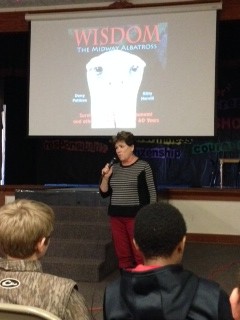
I came at the request of Joli, the PTA President.
Young, beautiful, and full of passion for her community, Joli Holzhauer is a living testament of the Power of One.
The city’s claim to fame is the annual Coon Supper, an event that no politician in Arkansas will miss. Bill Clinton attended the event for many years and brought with him the major political forces; this year, almost every candidate for major offices in Arkansas attended. The event often gets CNN or FoxNews coverage.

Wikipedia adds: “The largest alligator ever killed in Arkansas was harpooned near Gillett on September 19, 2010. The thirteen-foot one-inch reptile weighed 680 pounds.”
Joli met her husband, the current mayor of Gillett, at Mississippi State University, when he was planning a far different career; instead, he came home to farm. The area has cotton, soybeans, rice, corn and other crops which grow in this fertile, flat delta area. She says it was different at first from what she was used to, but she dug in and started working to support her community.
Rachel Mitchell, the principal of Gillett Elementary said that Joli comes in to chat and asks, “What do you need? What do you want?”
And then, Joli makes it happen. The PTA sold chocolate bars. Now, in a community of only 700 people (that includes children), how many chocolate bars can you sell? $3000 worth. Whatever the school needs or wants, one person is making a difference.

Intelligent, smart, committed. Small communities and their school survive because of people like Joli. I salute you!


30 Days to a Stronger Novel Online Video Course

The book is now
available for Pre-Order! It officially goes on sale on November 14.
When you’re writing or plotting a story, one way to approach it is to write out the story beats. A beat is a small action; a collection of beats makes up a scene. It’s sort of like choreographing a dance; you must make character move around, interact and do things. You can write story beats on the fly if you like, but I like doing some planning ahead so the actual writing is easier. If you, too, write story beats ahead, here are some things you should keep in mind.
- Where are the characters in space? Because beats represent physical actions of a scene, you must always keep in mind where the characters are in space. In a dining room, is mother on the other side of the table from her daughter or on the same side. If she’s on the other side, then she can’t reach out and touch her daughter. She must physically walk around the table to do that. You must always be aware of EXACTLY where each character is. Draw it out or act it out if necessary.

Where are we? The story’s setting determines the types of action possible. Moving around a marina is very different than running through a wooded area. Photo by Darcy Pattison.
- What is the moment before? When a scene opens, don’t have a character move out of empty space. For example, if you write, “Mom walked over to Lucy,” then I want to know where Mom started that walk. Where was she the moment before this started. Place her somewhere and give the reader enough context for the action to make sense.
- Can you name and transform an emotion? To help me write a scene, sometimes I need to actually name the emotional back and forth. Then, I work to push the emotion into the dialogue, the beats (actions) or the body language. If mother wants to appeal to her daughter for understanding, perhaps she pulls out a chair and sits, which puts her in a lower position than the daughter. If she holds up her hands, mother becomes a supplicant before the daughter and the beats/body language reinforce that mother is asking for understanding. Then, you don’t have to say it, because you’ve shown it. But naming it helps me keep the emotional tensions as tight as possible.
- Can you escalate the tension? Mother grabs the daughter’s arm. That’s definitely conflict. But when Mom squeezes harder, the tension escalates. Within a scene you want a mini conflict that rises to a small climax and you should be using the beats to help you escalate and build that tension. What beat did you list? How can you escalate that action in some way? Mom squeezes harder; mom’s face gets in daughter’s face; one of them shoves the other; and so on.
- What body Language would help express the beats? While you are writing out the beats, or the actions that characters take, it could be subtle changes of body language. One character leans closer to hear better. Another crosses arms over her chest to fend off a verbal attack. Avoid the clichés: looking away, spun away, tears rolled down her cheeks. Instead, look for fresh beats and fresh ways to use body language.
- Is the action clear? Above all, you must strive for clarity. Readers must never be confused about what is happening in a scene. Try to look at it with fresh eyes and see it as a first-time reader would see it. Clarity trumps pretty language every time.



30 Days to a Stronger Novel Online Video Course

I confess: I love a good cliche or trope.
A cliche is a phrase or expression that has been used so often that it is no longer original or interesting.
A trope is a common or overused theme or device, as in the usual horror movie tropes.
I’m in the middle of plotting a massive 3-book story and I need all the help I can get. Here’s the problem: what happens next?
No, let me rephrase: what could possibly happen next?
Sometimes, I just need to know possibilities, or what a story typically does at a particular stage. What are the possibilities? Is this a place for a murder, a confession, a love scene, or a time to gather information?
Literary folk say that there are only a limited number of stories in the world. Depending on who you talk with, there might be just two stories: a character leaves town, or a stranger comes to town. Others say there are up to 32 plots. I’ve written about 29 plot templates before. And it helps immensely to narrow down the choices.
But that’s on the level of an outline. Now that I’m deep into deciding on scenes, my imagination comes up short.
Enter tropes. A trope is a common theme, something that’s been done before. That doesn’t scare me away, because it’s the same as the variety of themes. Every story is a cliche, trope or template in many ways. It’s all in how you TELL that story. The beauty is in the particulars.
Romantic Subplot
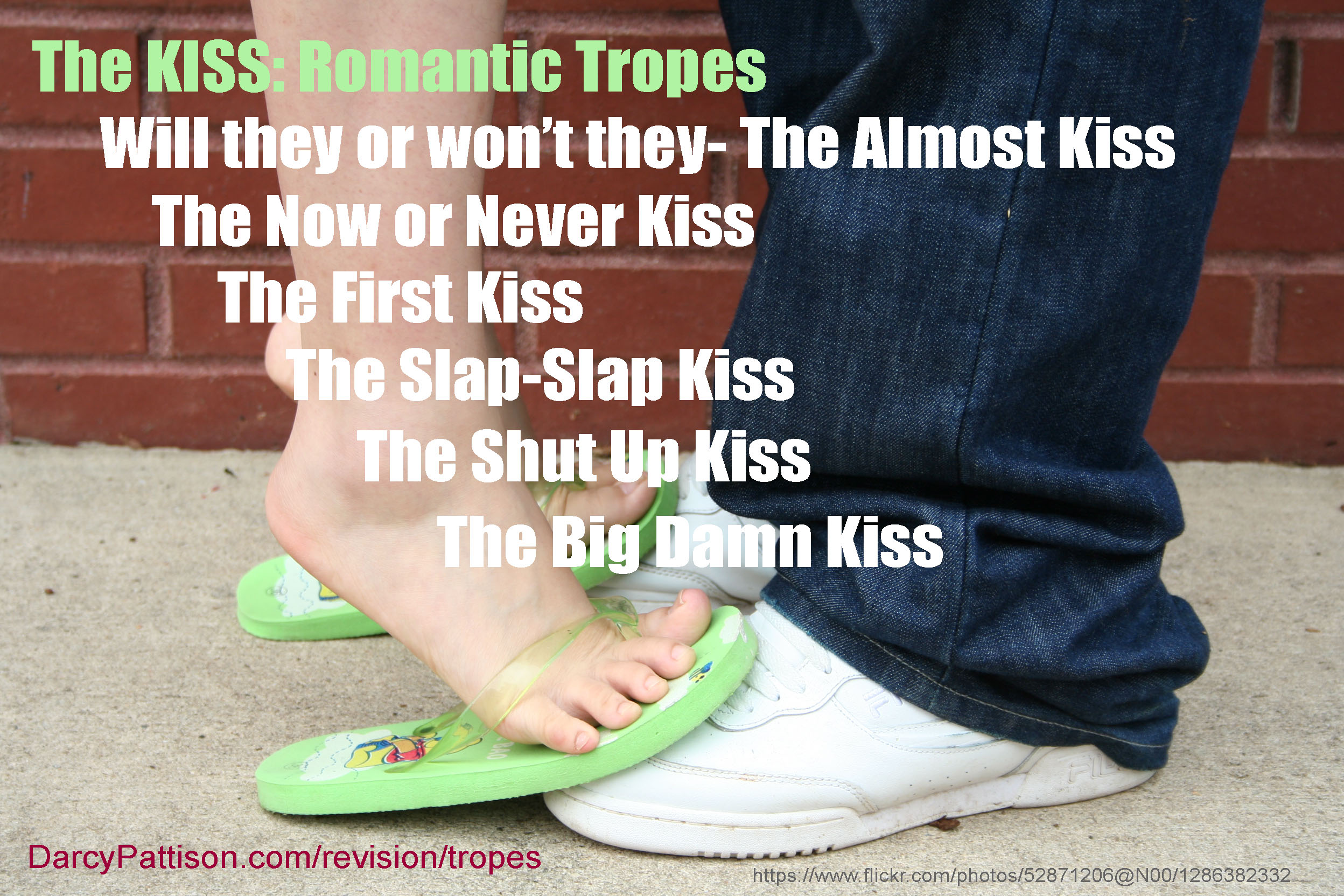
My story needs a romantic subplot. I know the basics.
Act 1: Boy Meets Girl/Girl Meets Boy
Act 2: Boy and Girl Fight or are otherwise kept apart.
Act 3: Boy and Girl get together.
But what else? What is possible at each stage?
I turned to TVTROPES.org for help. Their site is a wiki that list all sorts of tropes. The Romantic Arc Tropes list was helpful because it listed typical things that happen at every stage of a romantic relationship.
For example, a story might start with this trope/subtropes:
Love Before First Sight
- Because Destiny Says So
- Childhood Marriage Promise
- Red String of Fate
- Girl of My Dreams
- New Old Flame
Each of the tropes listed has its own wiki page, which explains the trope in detail. Particularly valuable are the examples drawn from traditional literature, manga, comic books, fanfics, films, live-action TV, professional wrestling, table top games, theater, video games, webcomics, western animation, real life and more. It’s a treasure trove of examples of the POSSIBILITIES of a particular stage of a relationship.
In fact, I used this romance arc by choosing one trope from each stage of a relationship and slotting that into my story.
Place Holders
Are you afraid that my story will be trite and boring? I’m not. I know that this is a trope and therefore, I must transform it in the storytelling phase of the project. Right now, though, this trope acts as a place holder, something that indicates approximately what will happen in this spot of the story, but not exactly. The nuances that make it fresh await the actual writing.
Using tropes to hold a place with something reasonable makes the plotting easier. I’m loving this help in plotting.
Here are some Arcs to get you started. Be warned: this is a massive wiki and it’s easy to get lost in it. Know what you are looking for and get it/get out.

30 Days to a Stronger Novel Online Video Course

30 Days to a Stronger Novel Online Video course

Writing teacher Darcy Pattison teachers an online video course, 30 Days to a Stronger Novel. Each day includes an inspirational quote, and tips and techniques for revising your novel. Here are the 10 of the inspirational quotes.
Or sign up for more information on the availability of this course and other courses.

The titles below are the first ten entries of the Table of Contents for the Online Video Class. Sign up now for the Early Bird list. You’ll be notified when the course goes live.
-
The Wide, Bright Lands: Theme Affects Setting

-
Raccoons, Owls, and Billy Goats: Theme Affects Characters

-
Side Trips: Choosing Subplots

-
Of Parties, Solos, and Friendships: Knitting Subplots Together

-
Feedback: Types of Critiquers

-
Feedback: What You Need from Readers

-
Stay the Course

-
Please Yourself First

-
The Best Job I Know to Do

-
Live. Read. Write.


Read on Wattpad - Serialized Novel
From September 11, 2014 - October 30, 2014.
Read one chapter/day.

Click on cover to read the first five chapters.
I’m warning you! Don’t plot like I do.
I’ve been working on the plot of a new novel for about six weeks and I’m still stumbling around. I’ll describe the messy process here and hope that you manage to shortcut your own process.
It started last year with an idea and a short story that gave backstory on the longer story. I’ve wanted to write a sf for a while and this idea has been germinating for a long time. Besides the problem of other projects, there’s the question of audience. I had to grapple with taking creative risks.
Take Creative Risks
One creative risk was the type of story I would tell. Would it be a character story or an action/adventure story?
I plotted out something, but my left brain kicked in and compared the plot to the 29 Plot Templates Regardless of which plot structure I looked at, there were so many holes in the story.
I got advice from Optimus Prime. Hey, I take help where I find it and Optimus was obviously handing out advice on plotting.
By now, though, I was getting bogged down. What was the purpose of all this plotting? I had to remind myself that I was telling a story.
The next disappointment was the worry about how slowly the work progressed.
Listen. I know a lot about novel structure, characterization, plotting, setting and many other topics about novels. I teach this stuff. But when I write, I struggle through the writing process. One of my strengths, though, is that I am open to switching strategies. It’s also my weakness, but while I’m in the throes of plotting, I feel like I am jumping from this method, to that paradigm, to yet another novel structure. In reality, I’m just checking out my story from multiple POVs.
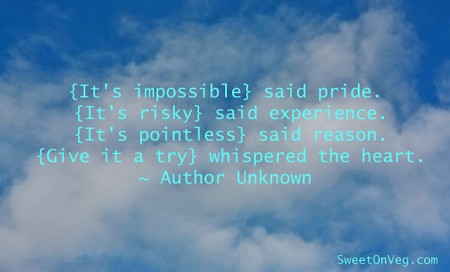
A Sixth Grade Aside
When my daughter was in sixth grade, she wrote an essay. The teacher asked my daughter to write an evaluation essay about writing the essay. Write down the process you went through to write this essay, the teacher advised.
And I shook my head in despair.
No, there isn’t just ONE path through the writing process. It’s cyclical, curving back on itself to ask you to repeat this task or that task. Or perhaps describing it as a maze is a better metaphor. I follow false trails until they dead end. I get lost in the middle and can’t fight my way out. I start at the beginning one time and the next time, I start at the end. Somehow, though, the writing gets done. There are strategies, ways of approaching a draft, working habits, and so on. But for any given piece of writing, the process will vary and vary widely.
Messy Writing Process
This time, I’m doing well with trying to go from general to specific.
That got me to an eight-page outline. But the 29 Plot Templates revealed major holes. I realized that I needed to concentrate on sub-plots and figure those out before I returned to the main plot. I focused on the villain as the hero of his own story: why did he want revenge? I re-read articles about writing a revenge story and one comment struck me: “Killing him would be too easy.”
Of course! Revenge isn’t just about hurting or killing the person; it’s about making them suffer as the victim has suffered. I asked myself, “What would make my character hurt/suffer the most?” Of course, that is what I MUST make happen. Voila! A new plot twist grabbed me and I was off and running with the complications from that twist.
10 page outline. But still lots of plot holes.
Over the next few days, I’ll be looking at other subplots and milking them for all the conflict that I can. Will there be a romantic subplot? After an initial attraction, there needs to be deep reasons why they must stay apart. What reason is sitting there in my story already, just waiting for me to exploit it? It’s there. I just need an Aha! Moment to recognize it. I’m jumping all around, reading odd articles, re-reading the 10-page outline and looking for the right way to approach this.
I feel like I am being asked to carve a huge statue with a bobby pin.
I have at least three more subplots to work through and slot into the main plot. I’m sure there will still be plot holes then, but I expect there will be fewer.
Should I copy this process the next time I plot? No!
Each time, the writing process creates it’s own maze and demands a different path to story. I’m just trusting that the process will eventually spit out a viable story. I know that I’ll have to decide something about the audience and tone, and spend a while on characters and their back story. I know that some personal issues are likely to complicate the timing of the writing. I know I’ll make multiple starts before I really get going.
Don’t follow my writing process. It’s messy and ugly. Besides—it wouldn’t work for you. You must find your own way through the maze of words to find the story that only you can tell.

Read on Wattpad - Serialized Novel
From September 11, 2014 - October 30, 2014.
Read one chapter/day.

Click on cover to read the first five chapters.
I am going to be serializing my novel, VAGABONDS: An American Fantasy, on Wattpad for the next 50 days.
Why Wattpad
Wattpad is a social media platform for readers and writers. Writers post stories and readers comment.
That’s almost enough reason right there to be on Wattpad:it’s a place where readers and writers connect.
The latest statistics say that 16.9 million readers find time to read at least 30 minutes/visit on Wattpad. These are not casual, glance at your website and five seconds later, they click off. When a reader finds a story that interests them, they read. They engage. They comment and vote up. Some call this the “YouTube of Writing.” Popular titles can have over 10M reads and more than 10,000 comments. WOW!
Science fiction, YA, and Fantasy. Over 20 genres are represented on Wattpad, but the most popular categories are science fiction, YA, and fantasy. VAGABONDS definitely fits the popular genre of fantasy, and should have appeal to teen readers. I describe it as a “Watership Down with armadillos.”
The platform provides statistics on how many people read each chapter. In other words, if you have a 50 chapter book and you lose readers after chapter 23–you have valuable feedback on when and where you went askew in your story.
2014 has been a year of experimentation for me. I’ve tried multiple ways to connect my books with the right readers and this seems like a reasonable thing to try. I’ll report in November how the month went. In the meantime–go to Wattpad and read the six chapters. Vote it up!

eBook Sale: August 26-31 only $0.99/regular $5.99
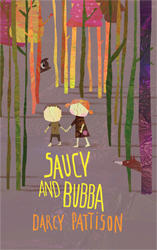 Available at these eBook stores
Mims House eBookStore
Nook
Kindle
Kobo
iBookstore
Available at these eBook stores
Mims House eBookStore
Nook
Kindle
Kobo
iBookstore
AUDIO BOOK (Unabridged): Now Available!
Available at these Audio Book stores
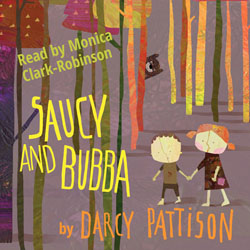 iTunes Store
Amazon
Audible
iTunes Store
Amazon
Audible
So, I have a general outline of my story but the writing still isn’t flowing. I realized that I need to break down major events into smaller sections, so I will know what to write.
I’ve gone through two stages of plotting or outlining, each one getting more specific. Here’s an example:
1. First, I stared with major plot points:
A volcano threatens to blow up, so Jake gets alien Rison technology to make it stop.
2. Second, I start to layout possible scenes.
At one point, he realizes he needs the alien technology, so he makes arrangements to get it. I wrote this: Later, at home, Jake contacts Mom, who gives him a contact on Rison who can ship him some technology and he orders what he needs to counter-attack the technology Cy used. Keeping up his volunteer work, Jake goes kayaking with Bobbie Fleming.
At this level, a scene may be summarized in a single sentence. However, it’s more helpful to break down both sentences further.
3. On the third pass, I’m looking to split up the action into several scenes, or at least flesh out the one scene a bit better.
Later, at home, Jake contacts Mom, who gives him a contact on Rison who can ship him some technology and he orders what he needs to counter-attack the technology Cy used. Conflict with Mom because he really wants to try swim team and she’s distracted b/c negotiations going so badly.
Keeping up his volunteer work, Jake goes kayaking with Bobbie Fleming. Bobbie Fleming, a harbor seal upsets Jake’s kayak. Of course, he has no problem with righting the canoe and getting back in and getting back to shore. But something nags at him, the waters feel more like home than the Gulf waters did. Something about being IN Puget Sound—there was something THERE. He had to find out what?

Plot is a way of examining story to see its underlying structure. Starting with a general idea and subdividing toward a specific plot often gives a writer the direction needed for the story to work.
Snowflakes and Phases
Need a more structured approach to something similar? The Snowflake Method, by Randy Ingermanson is a very structured approach that starts with a single sentence, and then splits that into two sentences, the two into four sentences, etc. until the story takes shape. It’s a structured outlining process with built-in steps for developing characters. Randy has a Ph.D. in theoretical physics, and his structured thinking shows in this method, which he’s turned into a software program and various books. If you need a very structured program, you may like the help you’ll get from the Snowflake Method.
Another option for approaching plot in a structured way is Lazette Gifford’s Phases system. You should read her original article about Phases here. She suggests that you write a numbered list of “phases” or short summaries of action. These can be scenes, transitions, thinking about what just happened and so on.
What I like here is the reference to the overall novel. Gifford suggests that you use MSWord’s auto-numbering feature to write phases for your novel.
For example, if you want to write 50,000 words, Gifford, in her free ebook, Nano for the New and Insane, breaks the 50,000 word length into phases:
- 60 Phases in the outline — 834 words per phase — 2 phase sections per day
- 120 Phases in the outline — 417 words
per phase — 4 phase sections per day
- 150 Phases in the outline — 334 words per
phase — 5 phase sections per day
- 300 Phases in the outline — 167 words
per phase — 10 phase sections per day
In other words, I can start with 60 phases and in that space, I should have a synopsis of the the beginning, middle, and end of the story. Or, if you’d rather, think of it as Acts 1, 2, and 3. Act 1 and 3 get about 15 phases each, which leaves 30 for Act 2.
That is comforting to me. I ONLY have to decide on 15 scenes (or discrete units) for Act 1. Act 1 looms HUGE for me, but 15 scenes sounds easy.
Phases allows me to do an easy, early check on the plot, too. Each phases needs moments of high arousal: excitement, inspiration, awe, anger, humor, action, disgust or outrage. Across the phases, I can easily check on how a subplot fits into the overall structure and how the subplot progresses.
Sixty phases is something that’s easy to see and understand. Once those are set, I may try to increase to 120 words, breaking down the plot into more specific actions.
If you’re doing NaNoWriMo, this also makes the task of 50,000 words in one day much easier.
Another thing I like about the Phase method is that it’s easy to see progress. I’m all about numbers and keeping score. On 9/5, I started with 23 phases; today, I’m up to 49 phases. My goal is 60 phases by the end of the week. Then I’ll look at it further to see if I want to go for 120 or if the 60 will be good enough to write from.

Find Darcy Pattison Books in the iBook Store
As a hybrid author, I have one foot each in two very different worlds. I am traditionally published and as an author/publisher, I release my own books.
The worlds operate at tangents to each other and one point of contention is this question: how long does it take you to write a novel? Independent author Dean Wesley Smith has recently finished a year of blogging about his daily output, which includes emails, blog posts, novels and short stories. For example in June, Smith wrote 52,800 words of fiction, 14,700 nonfiction, 14,000 for blog posts, and 827 emails of about 22,900 words, for a grand total of 105,200 words.
However, traditionally published authors often agonize over a novel for two or three years. Or more.
Let’s just ask the question straight out? Which method of writing produces great novels? Both.
And don’t let anyone convince you otherwise! Not editors and not indies.
Then why is there such a wide range of discussion on the merits of the two viewpoints on the speed of writing?
Fast or Slow? From the Business POV
From a Traditional-POV, publishers generate over 50% of their income on their backlist, books that continue to sell 1000 copies a year and do so year-after-year. Yes, they need to add new books each year, but because their income isn’t starting at zero, they can be very selective in adding new books. Another strength of traditional publishers is that they have multiple sources of new stories each year, i.e. multiple authors. In fact, they will seldom put all their eggs in one basket, especially not yours. If you write quickly, a publisher will only take ONE of your mss in any given year, at least until you build a stellar reputation.
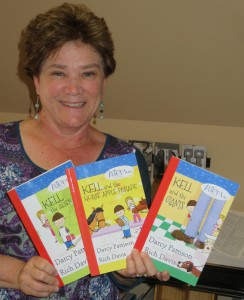
Writing the Aliens, Inc series was fast! Each book took a month to write and after comments, a week to revise. By contrast, a middle grade novel might take me a year to write.
By contrast, from a Business-POV, indie author/publishers need to write quickly. They need to quickly build a backlist that generates an ongoing income. One-book-wonders, or authors who only write one book every five years, would be foolish to go indie. Let’s say you need $1000 income from your books each month. If you only have one book out that one book MUST generate $1000 month-after-month. If, however, you have ten books out, each book must AVERAGE only $100 in sales, month-after-month. In any given month, Book 3 might sell zero and Book 9 might sell $1000. The key is that the books must AVERAGE only $100. If Book 5 contributes only $50, but does it consistently, month-after-month, that’s a valuable book for you. For a traditional publisher, though, that’s not enough income generated and they would put it out of print. (And some publishers are more wont to cut the lower producing books than others.)
Traditional publishers source stories from multiple sources, spreading the risk among many authors. Indie author/publishers have only one source of stories, and they must maximize their output.
Fast or Slow? From the Creative POV
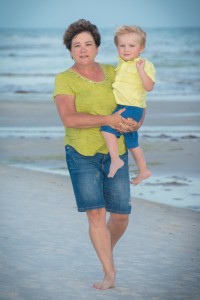
As my grandchildren are learning to walk and run, it’s tempting to compare the age at which they take that first step. NOT FAIR! Each child–like each novel you write–develops at its own pace. Comparison does nothing but add unnecessary anxiety.
Thus, you’ll hear editors saying, “Take your time. Get it right.”
Of course, editors advise writers to slow down. They can’t handle ten books from you in one year. If you write ten in a year, you’ll likely need 5-10 publishers (if you can find them), at least until you build that reputation for blockbuster sales.
Is there value in slowing down? Yes and no. Yes, it’s good to take the time to write well. Speed CAN lead to sloppiness, but it doesn’t necessarily. On the other hand, if your normal writing speed is fast, and you manage to turn out good stories, then slowing down feels like being hobbled. For some, it’s boring to write slow and only work on one project at a time.
The Indie world emphasizes the need for speed. Dean Wesley Smith once asked a group of writers how many words they write in an hour. I shrugged. I could easily write a 1000-words in an hour. Then he suggested that I should be writing 8000 words/day, which would be 192,000 words or about 4 middle-grade novels (or two full-length adult novels) per month.
Wait. Does that math work? Yes.
But it’s also not that easy. When I know what I want to write—such as this blog post—I can easily turn out 1000 words per hour. But writing a novel is a different task. I like the analogy of a spider spinning a web. From her gut, she must create the raw materials of spider web silk, and then like an architect, she lays in the foundations of her web, hanging for her life from that slender silk while she does so. Once the foundation threads are laid, she spins more silk—from her very gut—and weaves a circular web on that foundation. She then lies in wait for a victim to arrive.
Novelists spin characters and conflicts from their very guts and soul. We lay in the foundation of a novel’s plot, and then spin a story around that foundation. Finally, we lay in wait for a reader to be captured by the story.
Once I get a foundation laid, I can spin out that 1000 words per hour. It’s that first part, creating the story’s silk from my very soul, that is hard. As the creator of the Novel Revision Retreat, I also understand the imperative of revising multiple times to get a story right. I teach and practice that a first draft tells you what the story is; the following drafts are for finding a way to tell the story in the most dramatic way possible to hold readers’ attention.
My feet are firmly in both worlds. I need to produce works so I can build my indie backlist and thus up my income levels. However, I also understand that my process is slower than I’d like.
I am working on various ways to boosting productivity, such as learning Scrivener. But in the end, I’m left somewhere in the middle, and I don’t think it’s a matter of straddling the fence.
Honor Your Own Process
Instead, I think I am honoring my own process. For blog posts and picture books, I can and do write fast. But for novels, the thinking process is much slower than my ability to type. MUCH slower. It might take me six to twelve months to do this next novel. I refuse to be intimidated by the Indie crowd into going faster. Likewise, one of the appeals of being a hybrid or indie author is that no one can force me to slow down. I don’t have to wait a year for an editor to get back to me with revision notes. I don’t have to wait for an editor who promises a contract for fourteen months, and then rejects the novel, sending me into a new round of hopeful submissions.
Slow writing doesn’t equal good.
Slow writing doesn’t equal bad.
Fast writing doesn’t equal good.
Fast writing doesn’t equal bad.
Instead, I will write at the pace each piece of work demands and allows.
Working with Deadlines
There will always be the Tyranny of the Urgent. This week I’ll be going to North Andover, MA to teach a Novel Revision Retreat and that means I must have the teaching materials done by Wednesday. That’s my writing focus this week.
Fortunately, other deadlines loom in the future and those deadlines will demand that other projects consume my attention. For traditional publishers, the deadlines are few and far between. For indie publishing, I need to have books come out about six months before publication so they can be sent for review. Can I delay a book a month? Easily. But I try to set a publication date and stick with that. It’s a business thing.
Some argue that if you can write quickly under a deadline, then you could do it anytime. Not for me. Because a deadline FOCUSES my writing and writing time in a way nothing else can do.
In other words, external deadlines also affect my output. I still honor what a piece of writing demands, but at the back of my mind, I know what that demand is. And when I add that to the deadlines, I can instinctively allow more or less time before a deadline for that piece.
Do You Work Fast or Slow?
Good. Write at the pace that works for you for any particular project.
Learn from productivity tips and use whatever software is most productive for you. Don’t be intimidated by editors who demand slow work, or contemporaries who rave about the benefits of writing fast. In the midst of the swirl of opinions, write. Your way. Your stories. As David Bayles and Ted Orland say in Art and Fear, “Your job is to learn to work on your work.” I’ll add: And do it at your own pace.


By:
Darcy Pattison,
on 8/13/2014
Blog:
Darcy Pattison's Revision Notes
(
Login to Add to MyJacketFlap)
JacketFlap tags:
children's books,
school,
eBook,
book marketing,
school library,
Novel Revision,
ipad,
iBook,
ibookstore,
ebook distributors,
Follett ebooks,
Add a tag
Are online reviews important? YES!
"I had no idea how important online reviews are, or I would have done it months ago." Hugh Howey (author of WOOL series) fan
Have your books been updated and made for sale as ebooks? Are you on the Kindle store, the Nook store, or the Kobo store? Great.
But if you’re not on the iBook store, you’re missing sales. Here’s why.
In a recent 2014 survey by Education Market Research, they surveyed schools about what tablets they currently own. Apple’s iPad overwhelmingly wins the tablet wars with 79.7% of the market. Distant competitors include Microsoft Surface at 10.2% and Samsung Galaxy Note at 6.2%. Wow! iPads rule! In schools, at least, Kindles only have 1% of the market.
Further, respondents said there are 2.3 million tablets in U.S. schools. That means about 1.6 million iPads are floating around the school buildings. That’s a huge market that you can’t afford to ignore! Especially when the respondents were asked about future purchases. Again, iPad tops the market share with 65.7% planning to buy iPads.
See my books on the iBook store!
To see if your ebooks are on the iBookstore, use the iTunes Link Maker tool. Search for your name under the books category. In the comments below, report what you find!
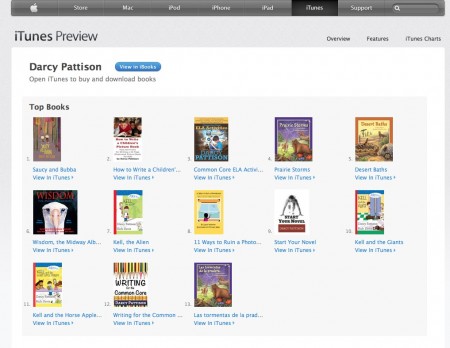
Darcy Pattison’s books on the iBookStore
Other eBook Options
Just because a school owns a dozen iPads, though, it doesn’t mean the school library will order from the iBookstore. Schools buying patterns are way more complicated because of factors such funding sources, issues related to inventory and checking out books, etc. In a September, 2013 article for Digital Shift, “SLJ’s School Ebook Market Directory,” Matt Enis and Sarah Bayliss run down 22 options that school have for purchasing ebooks for their libraries. Many options are simply a publishing company offering their backlist. Other options include ebooks from multiple publishers. The King among these options is Follett eBooks:
“Sixty-seven percent of PreS–12 schools using ebooks purchase from Follett, according to a recent Library Journal survey. Special features from Follett include note-taking capabilities in all titles and highlighting options in most, along with a tool allowing teachers and students to write and share notes. Additional Follett tools aim to support close reading and Common Core State Standards goals and offer scaffolding structures for struggling readers. Printing, copying and pasting, and text-to-speech features depend on publishers’ DRM specifications.”
One of the main reasons schools go to these ebook distributors is their desire to be “device independent” or “device agnostic.” They understand the limitations of being tied to a certain ebook reader. When a company provides “device independent” books, it usually means the ebooks are browser dependent. Any device which has a browser–such as Kindle Fire or iPads–can read that type of ebook. The versatility and universality of the browser dependent ebooks makes them an attractive option for schools. They aren’t tied to costly upgrades of tablets that tend to break. Instead, ebooks are read on whatever device is working.
Are your books available on these services? You’ll have to look up each one. Follett’s titles can be checked in their titlewave.com website, which is only available to customers. That means you’ll have to find a friendly children’s librarian to look it up for you. Yes, all my books are available on Follett’s ebook platform!
Finally, some publishers are making their eBooks available for purchase on their own websites. My indie books are available in epub or Kindle formats at MimsHouse.com. If you own the ebook rights to your books, you can sell them from your own website, too.
Book Reviews: A Difficult Ask
Of course, this means more work for authors as they work to get the oh-so-necessary-reviews. Already, we ask friends and family to review our books on Amazon/Kindle and maybe on GoodReads. KoboBooks used to pick up reviews from GoodReads, but since it’s been bought by Amazon, that’s not smart business; now, Kobo asks its customers to review on its site. And now, you should really ask for reviews on the iBookstore. Is it too much to expect from a friend?

COMING: March, 2015
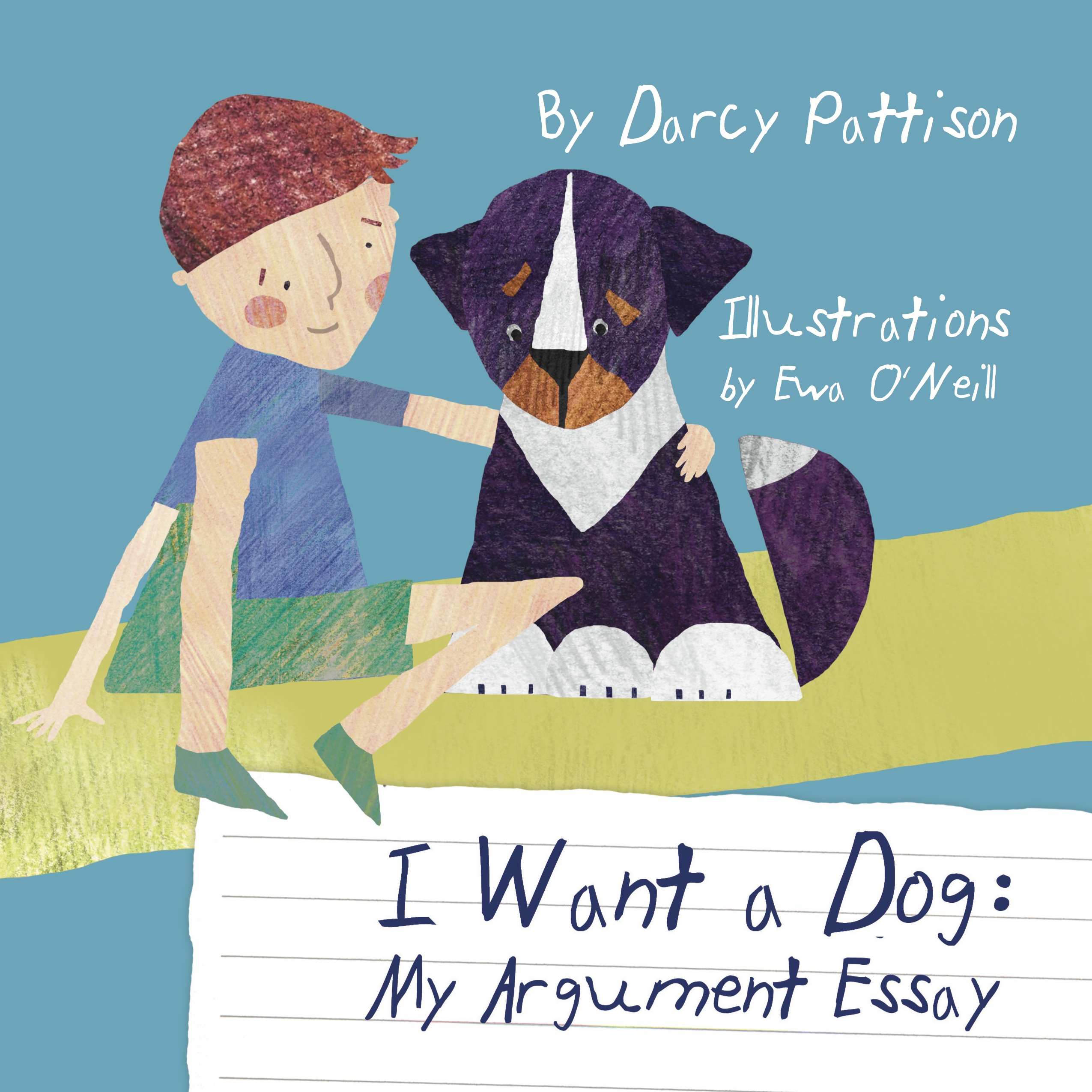
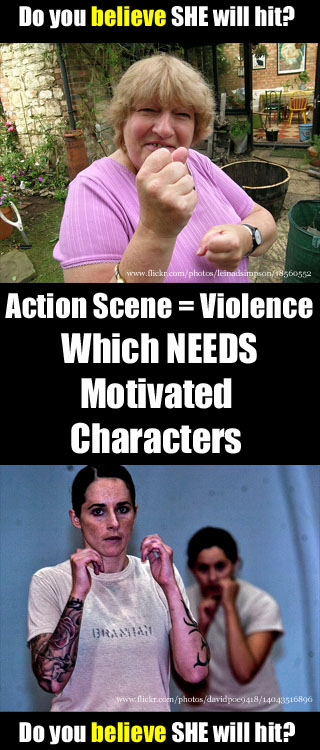 In my current WIP, I want to up the action and make this a physically exciting story. So, I bought a great ebook, Action! Writing Better Action Using Cinematic Techniques by Ian Thomas Healy. It’s great, as I said, and breaks down the actions into easy components that can be easily mastered. Even for me, it’s easy.
In my current WIP, I want to up the action and make this a physically exciting story. So, I bought a great ebook, Action! Writing Better Action Using Cinematic Techniques by Ian Thomas Healy. It’s great, as I said, and breaks down the actions into easy components that can be easily mastered. Even for me, it’s easy.
Healy says that great action scenes put characters into motion and the “effective description of that motion is what makes the difference. . .”
I get that part. But here’s what stumps me: “At its most basic level, an action scene is an expression of plot or character development through violence.”
Violence. As in people hitting each other, shooting at each other, killing each other. Yep. That kind of physical violence.
It’s been a long, long time since I was in a knock-down drag-out fight. That was with my younger brother when I was about 15, and we were fighting about whether the overhead light was on or off while we watched TV. I never had the chance to play football, which is a pure Show-Don’t-Tell version of testosterone. When my daughters played soccer, I cringed when they played tea party on the field: Oh, you have the ball? Well, take your turn and when you are finished, I’ll take my turn. Teaching aggression (much less violence) to young ladies is hard.
Our society trains women to avoid violence. We teach our daughters aggression now on a soccer field, but step off the field and it’s tea party time again. Women writers are at a disadvantage in writing action scenes.
Because Healy says that a great action scene needs violence.
Heck, I can’t even work up a good case of Road Rage.
Motivation. The hardest thing for me is to motivate the characters. I can block out the action and get the characters fighting. I’ve seen enough action movies to be able to do it. (Go watch The Transformers latest movie if you want non-stop violence. Wow. It must take up 75% of that movie.)
But WHY are these characters resorting to violence? (See, even our language makes it hard to use violence: “resort” implies that violence is a last option and the choice to use it is not easy.) Why would the characters use fists, swords, guns or other weapons against someone else? Healy helps with blocking out the sequences of actions and building them into longer sequences. But he says little about the character motivations.
In one sense, this is an escalating of tensions. Almost any motivation would work: revenge, for example, could easily escalate into violence. Two rivals for a fortune in gold could escalate an argument into violence and death. For violence to take place, there’s a line that needs to be crossed. Polite society demands that people restrain themselves, and that self-control must break for your characters, shoving them into a no-holds-barred action. Violence. It’s an escalation and it’s a letting go of social restraints. It’s a willingness to take action and a determination to get something done—no matter what.
Sounds like a good way to increase the tension and stakes in a story. Yes, often action stories are physical stories, without much in the way of characterization. You’ve heard it said that you either write an action story or you write a character story. A cross-pollination though, could create an intriguing mix. This time, I’m shooting for a story with better balance between action and character.
Cinematic. In some ways, this mix will be more cinematic. The sights and sounds of the action are crucial to the success of the scene. And yes, as I am writing, I am trying to visualize the actions in my head; I’m trying to see it as if it is on the big screen. Healy’s title is right on, violence—action scenes—are cinematic.
Thanks to Healy’s advice, I am making lists of what he calls “stunts,” or isolated pieces of actions, that will build into “engagements,” or movement across a setting, which will ultimately build toward some climactic “resolution.” I am taking baby steps in building a chapter with interesting action, um, violence.
Look out. I’m strapping on my boxing gloves, er, getting ready to type the next chapter of this new action-adventure story.

The ALIENS have landed!
"amusing. . .engaging, accessible," says Publisher's Weekly
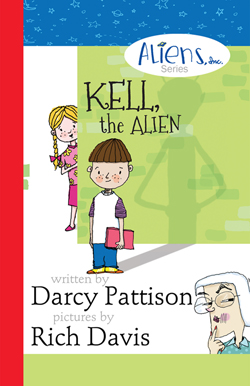 |
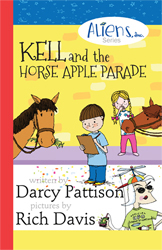 |
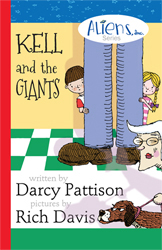 |
To write a series of books, my biggest tip is to plan ahead. You may get by with writing one book on the fly—plenty of people do that. But for a series to hang together, to have cohesion and coherence, planning is essential. Here are three decisions you should make early in the planning process.
Decision #1: What type of series will you write?
Strategies for a series vary widely. For THE HUNGER GAMES, the story is really one large story broken down into several books. Or, to say it another way, there is a narrative arc that spans the whole series. Yes, each book has a narrative arc and ends on a satisfying note; however, we read the next book because we want to know what happens in the overall series arc. Jim Butcher’s ALERA CODEX is another series with an overall series arc; it was fun to hang out in this world for a long time.
On the other hand, series such as Agatha Christie mysteries (in fact, many mystery series fall into this category) are stand-alone books. What continues from one book to the next is the characters, the setting and milieu, and the general voice and tone of the stories. Once a reader gets to know a character, s/he wants to spend more time with that character. These readers just want to hang out with a friend, your character. A sub-category is the series of standalone books that adds a final chapter to set up the next book in the series and leaves you with a cliff-hanger.
I distinctly remember when I first read Edgar Rice Burrough’s John Carter series about Mars. Each story is a standalone novel, but he hooked me hard. I started reading at noon on a Saturday and found myself hotfooting it to the bookstore at 4:30 pm because they closed at 5 pm and I had to have the second book to read immediately.
Rarer is the series that crosses genres. This type series begins with one genre, but moves into other genres as the lives of the characters progress. For example, a romance might continue with a mystery for the second book. And the third might move into a supernatural genre. These are rarer because one reason a reader sticks with a series is that they know what they are getting. It will be this type of a story, told in this sort of way and will involve these characters.
On the other hand, some series unabashedly cross genres but they do it for every book. Rick Riordian’s Percy Jackson series is a combination of mythology and action/thriller with a dose of mystery.
Notice that this decision centers on the plot of the stories in the series. Will you plot each separately, or will there be an overall plot?
Decision #2: Characters
Besides plot, you should make decisions about characters, and as with plot, you have choices. One choice is an ensemble cast that will carry over from book to book. Here, you have Percy Jackson, his friends and his family as constants. Each book introduces new characters, of course, but there is a core that stays the same.
Another option is to have just one character remain the same. Agatha Christie had Hercule Poirot traveling around and the only constant was the gumshoe and his skills.
Whether you choose one character or an ensemble, you can add or subtract as you go along. But the characters must be integral to the story’s plot.
In developing series characters, think about cohesion and coherence.
Cohesion: Elements of the story stick together, giving cohesion. For example, if one alien in the family can use telekinesis (moving objects with your mind), then that possibility should exist for all members of the family. Of course, some might not have the power, or it may develop slowly for a child, but the possibility should exist.
Coherence: Elements of a story are consistent from book to book. If Kell’s eyes are silvery in book one, they are silvery in books two, three and four.
Decision #3: How long do you want the series to continue?
Many easy readers series go on forever. Think of THE BERENSTAIN BEARS, who continue their adventures and lives throughout multiple volumes. For this type series, the story possibilities are endless. Or think of a TV series, where the situation set up is rich with possibilities. I Love Lucy ran for years and years on the premise of a slightly crazy wife of a musician.
On the other hand, some series have a finite life span. For stories with a narrative arc that spans a series, the life span is built into the plot. However even for these, there can be spin-offs into related series. Think of Percy Jackson and the Olympians series and Heroes of Olympia series. The A to Z Mysteries by Ron Roy and John Gurney had a built-in limit of 26 books.
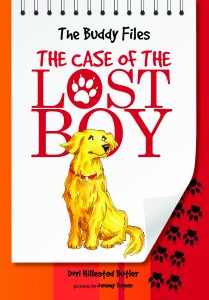
The Buddy Files Series, Book 1, by Dori Hillestad Butler
Sometimes, the length of a series depends on the publisher and the early success of the series titles. When Dori Hillestad Butler’s first book in
The Buddy Files series, THE CASE OF THE LOST BOY, won the 2011 Edgar Award for the best juvenile mystery of the year, the publisher contracted for more.
For Sara Pennypacker, author of the CLEMENTINE series of short chapter books, the answer of series length depended on something else. In a presentation about writing, she said that she had to ask herself what she wanted to say to third graders. She came up with eight things. Pennypacker focused on the themes of each book (friendship, telling the truth, etc) and found that eight was the natural stopping place for her. Of course, she reserves the right to many more, if other themes present themselves. But she deliberately stepped away from doing a Christmas book, a Halloween book, a 4th of July book, a fall book, a back-to-school book and so on and so forth.
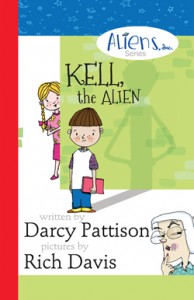 My books, THE ALIENS, INC. SERIES, just released in August, 2014, is about an alien family that is shipwrecked on Earth and must figure out how to make a living. It’s been interesting developing these stories and thinking about these three issues.
My books, THE ALIENS, INC. SERIES, just released in August, 2014, is about an alien family that is shipwrecked on Earth and must figure out how to make a living. It’s been interesting developing these stories and thinking about these three issues.
They accidentally fall into party planning and each book features a different type of party or event put on by Aliens, Inc, the family’s company. KELL, THE ALIEN, the lead-off story, is about a birthday party and of course, it is an alien party. Can the aliens pull off an alien party? The second is about a Friends of Police parade, entitled, KELL AND THE HORSE APPLE PARADE. Book 3, KELL AND THE GIANTS, explored the world of tall and how to keep a giant secret.
Can you tell just from the description some of the decisions I made? There isn’t an overall series arc. Rather, the characters, setting and milieu are set up and there could be endless stories in the series. However, like Butler’s dog mystery series, I am starting with four books and their success will determine future titles. There is a main character who is surrounded by friends and family and, of course, a villainess. These characters weave through the stories and provide cohesion and coherence.
Plan ahead and your series will be stronger. For those who accidentally fall into a series, it will be harder to sustain coherence. You may realize in book three that it sure would be nice if your character had to wear glasses. Yes, you can add it—but you run the danger of it being obviously done for the story itself. So, in my series, early readers have questioned things like the art teacher who is from Australia.
They ask, “Does it matter that she is from Australia?”
“Not yet,” I answer. I just know that I have seeded these early manuscripts with possibilities. If the series goes to books 5-8, I will have hooks to draw upon. So, while I haven’t plotted those books, I have still allowed room for them.
Resource: Writing the Fiction Series: The Complete Guide for Novels and Novellas by Karen S. Wiesner (Writer’s Digest Books)
Want to write a series? What is your favorite series and how will your stories compare?

The ALIENS have landed!
"amusing. . .engaging, accessible," says Publisher's Weekly
 |
 |
 |
Have seen this video about grammar by Weird Al Yankovic? It’s a hoot!
It was posted on July 15, 2014, and it already has almost 10,000,000 views.
If you can’t see this video, click here.

View Next 25 Posts





